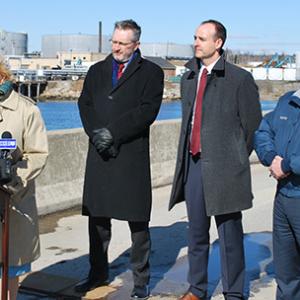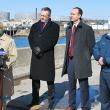Gov. Mills announces steps to prepare for offshore wind investments, with Searsport as core infrastructure
SEARSPORT — The Mills Administration announced Tuesday next steps in the Maine Offshore Wind Initiative’s effort to prepare Maine’s commercial seaports to advance the University of Maine’s patented floating offshore wind technology and attract offshore wind industry investment in Maine.
The actions of the administration come as demand for offshore wind energy and related port facilities has increased since the Biden Administration announced in March a new federal target of 30 gigawatts of offshore wind energy by 2030. Last month, the Department of Interior announced plans to advance commercial-scale offshore wind, including in the Gulf of Maine, in coming years.
“The Gulf of Maine has some of the strongest winds in the world, and Maine has among the most accessible deep-water ports on the East Coast. When combined with our manufacturing base, pioneering research and technology into floating offshore wind, and an unparalleled workforce with expertise in marine fields, offshore wind presents an unprecedented economic and investment opportunity for Maine.”
The existing infrastructure, transportation links, deep-water access, and room to grow at Maine’s commercial seaports are a competitive advantage for Maine to develop good-paying jobs in clean energy fields, maritime careers, manufacturing and fabrication trades, engineering, shipping and more in the offshore wind industry.
“I have today directed my administration to assess the infrastructure at Maine’s commercial seaports and any added investment needed to support opportunities in offshore wind,” said Gov. Mills. “Led by the Governor’s Energy Office, the Department of Transportation and other agencies as necessary, we will evaluate multiple port development options and study possible offshore wind uses at the Port of Searsport, the Port of Portland, the Port of Eastport, and others, to examine how to use Maine’s extensive marine capacities to support the emerging offshore wind industry.”
Investment in Maine’s seaports will also help advance patented floating offshore wind technology developed at the University of Maine. The first planned use of UMaine’s floating platform, a one-turbine demonstration project slated for deployment in 2024 by New England Aqua Ventus, is expected to use the ports of Eastport and Searsport for assembly and transportation.
“Offshore wind is a great opportunity to fight climate change. It also opens up a new world of jobs for Maine people, an economic incentive for young people to stay in their home state or to move here and make it their home,” said Gov. Mills. “It is an opportunity to show the world how much Maine has to offer to the technologies of the future. It is now time, particularly in light of federal funding opportunities, to consider improvements to Maine’s ports.”
In March 2020, Governor Mills directed MaineDOT to study the Port of Searsport to assess needs to support Maine’s offshore wind industry. An active seaport since the 1700s, the Port of Searsport is among the most versatile port sites on the East Coast.
The study, which evaluated physical and technical characteristics of various locations in the Port of Searsport, identified multiple sites for consideration as part of a hub for offshore wind, including Mack Point terminal and an area of state-owned Sears Island that is reserved for development. That site, according to the study, is recommended for further environmental analyses, geotechnical assessment, and preliminary design work to gauge environmental impacts and evaluations of alternatives, as would be required by federal and state permitting.
Based on the study recommendations, the Administration has informed the Town of Searsport about its intent to conduct further environmental and geotechnical surveys in the area. Governor Mills has also directed her administration to conduct a robust public process and engage with key stakeholders and community organizations about the Port of Searsport.
“We look forward to working closely with MaineDOT as they work to further assess improvements to the Port of Searsport,” said Searsport Town Manager James Gillway. “We know this will be a thoughtful and open process to explore the role our port will play in the support of the offshore wind industry. We look forward to realizing the economic benefits of putting more port into Searsport, while we preserve the ecological and recreational aspects of what makes us special. It is exciting to think that Searsport might play a role in the future of renewable energy thus reducing our country’s carbon footprint and contributing to actually saving the planet.”
A MaineDOT study of other Maine ports, a companion to the Port of Searsport study, is also underway. That study is evaluating how to strategically align Maine’s ports for offshore wind investment and infrastructure, while minimizing impacts on fishing, marine industries, and working waterfronts.
For more information on the Maine Offshore Wind Initiative, visit maineoffshorewind.org.
























